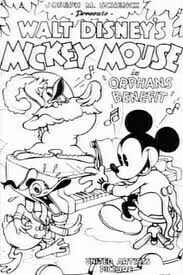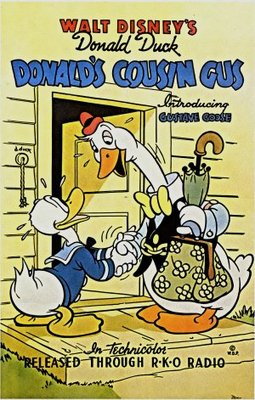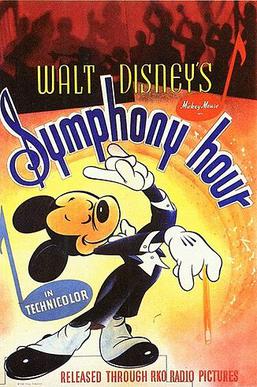
Goofy is an American cartoon character created by the Walt Disney Company. He is a tall, anthropomorphic dog who typically wears a turtle neck and vest, with pants, shoes, white gloves, and a tall hat originally designed as a rumpled fedora. Goofy is a close friend of Mickey Mouse and Donald Duck, and is Max Goof's father. He is normally characterized as hopelessly clumsy and dim-witted, yet this interpretation is not always definitive; occasionally, Goofy is shown as intuitive and clever, albeit in his own unique, eccentric way.
John Frederick Hannah was an American animator, writer and director of animated shorts.

Orphan's Benefit is an American animated short film produced by Walt Disney Productions in black-and-white. It was first released in 1934 and was later remade in Technicolor in 1941 under the corrected title Orphans' Benefit. The cartoon features Mickey Mouse and his friends putting on a vaudeville-style benefit show for a group of unruly orphans. It contains a number of firsts for Disney, including the first time in which Mickey Mouse and Donald Duck appear together, and was the 68th Mickey Mouse short film to be released, and the sixth of that year. It was also the cartoon which had the first story to be written that featured Donald Duck, though it was the second Donald Duck short to be produced and released, after The Wise Little Hen.

Donald's Cousin Gus is a Walt Disney cartoon released on May 19, 1939. Gus Goose debuted as a recurring character in Al Taliaferro's Donald Duck newspaper comic since 9 May 1938.

Der Fuehrer's Face is an American animated anti-Nazi propaganda short film produced by Walt Disney Productions, created in 1942 and released on January 1, 1943 by RKO Radio Pictures. The cartoon, which features Donald Duck in a nightmare setting working at a factory in Nazi Germany, was made in an effort to sell war bonds and is an example of American propaganda during World War II. The film was directed by Jack Kinney and written by Joe Grant and Dick Huemer. Spike Jones released a version of Oliver Wallace's theme for the short before the film was released.

Moose Hunters is a 1937 American animated short film produced by Walt Disney Productions and released by United Artists. It was the 93rd short in the Mickey Mouse film series, and the fourth for that year. The cartoon stars Mickey Mouse, Donald Duck, and Goofy on a moose hunting expedition. It was directed by Ben Sharpsteen and features music by Paul J. Smith. The voice cast includes Walt Disney as Mickey, Clarence Nash as Donald, and Pinto Colvig as Goofy.

Symphony Hour is a 1942 American animated short film produced by Walt Disney Productions and released by RKO Radio Pictures. The cartoon depicts Mickey Mouse conducting a symphony orchestra sponsored by Pete. The film was directed by Riley Thomson and features music adapted from the "Light Cavalry Overture" by Franz von Suppé. The voice cast includes Walt Disney as Mickey, Billy Bletcher as Pete, and John McLeish as a radio announcer. It was the 117th short in the Mickey Mouse film series to be released, and the second for that year.

Clown of the Jungle is a 1947 American animated short film directed by Jack Hannah and produced by Walt Disney, featuring Donald Duck. It marks the first short film appearance of the Aracuan Bird, previously seen in The Three Caballeros (1944). In the short film, Donald Duck is visiting the jungle to photograph its tropical birds, but things take a turn for the worse when Donald encounters the extremely annoying Aracuan Bird.
On Ice is a 1935 theatrical cartoon short in the Mickey Mouse film series, produced by Walt Disney Animation Studios. It was the 79th Mickey Mouse short film to be released, and the eighth of that year.
The Spirit of Mickey is an American animated direct-to-video anthology film, produced and released by Walt Disney Home Video on July 14, 1998. It features clips from The Mickey Mouse Club, The Wonderful World of Disney, and A Goofy Movie, in the introductory scene, and some of the namesake character's shorts, including The Band Concert, Lend a Paw, Mr. Mouse Takes a Trip and Steamboat Willie.

Mickey's Amateurs is a 1937 American animated short film produced by Walt Disney Productions and released by United Artists. Originally entitled Mickey's Amateur Concert during production, the cartoon depicts an amateur talent show hosted by Mickey Mouse. It was the 94th short film in the Mickey Mouse film series, and the fifth for that year. It was co-directed by Pinto Colvig, Erdman Penner, and Walt Pfeiffer, and features original and adapted music by Oliver Wallace. The voice cast includes Walt Disney as Mickey, Clarence Nash as Donald Duck, Florence Gill as Clara Cluck, and Pinto Colvig as Pete and Goofy.

Moving Day is a 1936 American animated short film produced by Walt Disney Productions and released by United Artists. The cartoon, set during the contemporary Great Depression, follows the antics of Mickey Mouse, Donald Duck, and Goofy as they frantically pack their belongings after being dispossessed from their home. The film was directed by Ben Sharpsteen and includes the voices of Walt Disney as Mickey, Clarence Nash as Donald, Pinto Colvig as Goofy, and Billy Bletcher as Sheriff Pete. It was the 85th Mickey Mouse short to be released, and the eighth of that year.

Squatter's Rights is a 1946 animated short film produced in Technicolor by Walt Disney Productions. The cartoon is about a confrontation between Pluto and Chip and Dale who have taken up residence in Mickey Mouse's hunting shack. It was the 119th short in the Mickey Mouse film series to be released, and the only one produced that year.

Tea for Two Hundred is an American animated short film directed by Jack Hannah. Part of the Donald Duck film series, the film was produced in Technicolor by Walt Disney Productions and released to theaters by RKO Radio Pictures on December 24, 1948. The cartoon stars a picnicking Donald Duck who faces an army of African ants trying to steal his food. Clarence Nash stars as Donald while the ants were voiced by Pinto Colvig. The film includes original music by Oliver Wallace.

Pluto's Christmas Tree is a 1952 Mickey Mouse cartoon in which Pluto and Mickey cut down a Christmas tree that Chip n' Dale live in. It was the 125th short in the Mickey Mouse film series to be released, and the second for that year. While the chipmunks are usually antagonists of Donald Duck, they have pestered Pluto before, in Private Pluto (1943), Squatter's Rights (1946) and Food for Feudin' (1950).
Springtime for Pluto is a cartoon made by Walt Disney Productions in 1944. It was directed by Charles Nichols.

Frank Duck Brings 'Em Back Alive is a 1946 animated short film produced by Walt Disney Productions and released by RKO Radio Pictures. In this installment of the Donald & Goofy series, Donald Duck appears as "Frank Duck", a jungle explorer determined to capture a live "wild man", played by Goofy. The film was directed by Jack Hannah and features the voices of Clarence Nash as Donald and Pinto Colvig as Goofy.

Inferior Decorator is a 1948 animated Donald Duck short film produced in Technicolor by Walt Disney Productions and released to theaters by RKO Radio Pictures.
Slide, Donald, Slide is an American animated short film directed by Jack Hannah. In the short film, Spike the Bee listens to classical music while Donald listens to the World Series and the two fight each other over the radio. Part of the Donald Duck film series, the film was produced in Technicolor by Walt Disney Productions and released to theaters by RKO Radio Pictures on November 25, 1949.
Honey Harvester is a 1949 animated short film featuring Donald Duck. It was released by Walt Disney Productions.














